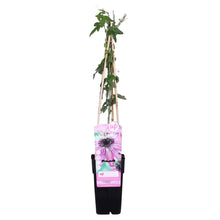Passiflora 'Purple Haze' is a vigorous and captivating passionflower cultivar, admired for its profusion of large, exotic-looking flowers. This semi-evergreen climber features lush, green foliage and produces an abundance of stunning blooms from mid-summer to early autumn. The flowers are typically white with a mesmerizing display of vibrant purple filaments and a unique central structure with green and purple markings. They also have a light, pleasant fragrance and are highly attractive to pollinating insects. This passionflower is a fantastic choice for adding a touch of the tropics to a sheltered wall, fence, or trellis in the garden, or it can be grown in a conservatory or greenhouse for earlier blooms and protection from harsh winter conditions.
Origin: Passiflora 'Purple Haze' is a hybrid cultivar, likely resulting from a cross between different Passiflora species. Its exact origin is not widely documented.
Light: Passiflora 'Purple Haze' thrives in full sun, but it can tolerate some light shade, especially in hotter climates. It prefers a warm, sheltered location with at least 6 hours of sunlight per day to encourage optimal growth and flowering.
Water: Water regularly, especially during dry periods and the first year after planting. Passionflowers prefer consistently moist, well-drained soil. Avoid overwatering, which can lead to root rot.
Soil: This vine prefers fertile, well-drained soil. It can tolerate a range of soil types, but thrives in loamy soil with a slightly acidic to neutral pH.
Support: Passiflora 'Purple Haze' is a climbing vine that needs support to grow. Provide a sturdy trellis, pergola, or wires for the vine to climb on.
Pruning: Prune your Passiflora 'Purple Haze' in late winter or early spring to maintain shape and control size. You can also prune lightly throughout the growing season to remove any dead or damaged growth.
Pests and Diseases: Keep an eye out for common pests such as aphids, scale, and spider mites.
Uses: Passiflora 'Purple Haze' is primarily grown as an ornamental vine for its beautiful and exotic flowers. It can be used to adorn walls, fences, trellises, and arbors, adding a touch of tropical flair to the garden.
Toxicity: The leaves and unripe fruits of Passiflora 'Purple Haze' may contain cyanogenic glycosides, which can be toxic if ingested in large quantities. However, the ripe fruits are generally considered safe to eat, although they may not be particularly palatable.



